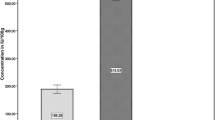Abstract
The antioxidative properties of different organic and aqueous fractions obtained by solvent fractionation of 80% methanolic extract of Hizikia fusiformis were investigated for free-radical, reactive oxygen species scavenging (O2⋅−, H2O2, HO⋅, NO⋅), metal chelation, reducing power and lipid peroxidation (conjugated diene and thiobarbituric acid reactive substances formation) inhibition assays. Of the organic and aqueous fractions tested, the organic ethyl acetate and aqueous chloroform fractions were notably effective. Almost all fractions exhibited significantly higher activities on NO⋅ and 1,1-diphenyl-2-picrylhydrazyl scavenging compared with commercial antioxidants. The organic chloroform fraction showed the highest HO⋅ scavenging activity among other counterparts. The aqueous chloroform fraction demonstrated O2⋅− scavenging and metal chelating activities that are similar to those of butylated hydroxytoluene. The lipid peroxidation inhibition was significantly higher in the organic ethyl acetate fraction than that of α-tocopherol. These data suggest that both organic and aqueous fractions are rich in hydrophobic and hydrophilic antioxidative compounds with different antioxidative properties.




Similar content being viewed by others
References
Yıldırım A, Mavi A, Oktay M, Kara AA, Algur ÖF, Bilaloglu V (2000) J Agric Food Chem 48:5030–5034
Halliwell B, Gutteridge JM (1989) Free radical in biology and medicine. Clarendon, Oxford, pp 23–30
Halliwell B (1994) Lancet 67:85–917
Fridovich I (1995) Annual Rev Biochem 64:97–112
Yang MY, Han YK, Noh BS (2000) Korean J Food Sci Technol 9:146–150
Ukeda H, Shimamura T, Tsubouchi M, Harada Y, Nakai Y, Sawamura M (2002) Japan Soc Anal Sci 18:1151–1154
Büyükokuro¢g¨lu ME, Gülçin I, Oktay M, Küfrevio¢g¨lu Ö (2001) Pharmacol Res 44:491–5
Shahidi F, Wanasundara PKJPD (1992) Crit Rev Food Sci Nutr 32:67–103
Harris ML, Schiller HJ, Reilly PM, Donowitz M, Grisham MB, Bulkley GB (1992) Pharmacol Exp Ther 53:375–408
Wagner JR, Motchnik PA, Stocker R, Sies H, Ames BN (1993) J Biol Chem 268:18502–18506
Madhavi DL, Deshpande SS, Salunkhe DK (1996) Food Antioxidants. Basel, New York, pp 1–4
Gülçin I, Oktay M, Küfrevio¢g¨lu Ö, Aslan A (2002) J Ethnopharmacol 79:325–329
Sherwin ER (1990) In: Branen R (ed) Food additives. Marcel Dekker, New York, pp 139–193
Gülçin I, Büyükokuroglu ME, Küfrevioglu ÖI (2003) J Pineal Res 34:278–281
Hotta H, Nagano S, Ueda M, Tsujino Y, Koyama J, Osakai T (2002) Biochem Biophys Acta 1572:123–132
Rice-Evans CA, Muller NJ, Bolwell PG, BramLey PM, Pridham JB (1995) Free Radic Res 22:375–383
Jorgensen LV, Madsen HL, Thomsen MK, Dragsted LO, Skibsted LH (1999) Free Radic Res 30:207–220
Xiaojon Y, Yoshihiro C, Masahiro S, Tadahiro N (1999) Biosci Biotechnol Biochem 63(3):605–607
Athukorala Y, Lee KW, Song CB, Ahn CB, Shin TS, Cha YJ, Shahidi F, Jeon YJ (2003) J Food Lipids 10:179–265
Siriwardhana N, Lee KW, Kim SH, Ha JW, Park GT. Jeon YJ (2003) food Sci Tech Int 10:65–68
Siriwardhana N, Jeon YJ, Kim SH, Ha WJ, Lee KW (2003) Algae 19:59-68
Heo SJ, Lee KW, Song CB, Jeon YJ (2003) Algae 18:71–81
Ruperez P, Ahrazem O, Leal JA (2002) J Agric Food Chem 50:840–5
Nakano T, Watanae M, Sato M, Takeuchi M (1995) Plant Sci 104:127–133
Yoshie Y, Wang W, Petillo D, Suzuki T (2000) Fish Sci 66:998–1000
Nakamura T, Nagayama K, Uchida K, Tanaka R (1996) Fish Sci 62:923–926
Santoso J, Yoshie Y, Suzuki T (2002) Fish Sci 68(Suppl):1647–1648
Kim KI, Seo HD, Lee HS, Cho HY, Yang HC (1998) Korean J Food Sci Nutr 27:1204–1210
Nagai T, Yukimoto T (2003) Food Chem 81:327–332
Siriwardhana N, Lee KW, Kim SH, Ha JH, Jeon YJ (2003) Food Sci Tech Int 9(5):0339–348
Brand-Williams W (1995) Food Sci Technol (Lond) 28:25–30
Nagai T, Inoue I, Inoue H, Suzuki N (2003) Food Chem 80:29–33
Muller HE (1995) Zentralbl Bakterio Mikrobio Hyg 259:151–158
Chung SK, Osawa T, Kawakishi S (1997) Biosci Biotechnol Biochem 61:118–123
Garrat DC (1964) The quantitative analysis of drugs, vol 3. Chapman and Hall, Japan, pp 456–458
Decker EA, Welch B (1990) J Agric Food Chem 38:674–677
Oyaizu M (1986) Jpn J Nutr 44:307–315
Roozen J, Frankel E, Kinsella J (1994) Food Chem 50:1183–1190
Madsen HL, Sorensen B, Skibsted LH, Bertelesen G (1998) Food Chem 63(2):173–180
Chandler SF, Dodds JH (1993) Plant Cell Rep 2:105–110
Cheeseman KH, Slater TF (1993) Br Med Bull 49:481–493
Hatano T (1995) Nature Med (Tokyo) 49:357–363
Hatano T, Edamatsu R, Mori A, Fujita Y, Yasuhara E (1989) Chem Pharm Bull 37:2016–2021
Ruberto G, Baratta MT, Biondi DM, Amico V (2001) J Appl Physio 13:403–407
Liu F, Ng TB (2000) Life Sci 66:725–735
Kitada M, Igarashi K, Hirose S, Kitagawa H. (1979) Biochem Biophys Res Commun 87:38–94
Marcocci PL, Sckaki A, Albert GM, (1994) Methods Enzymol 234:462–475
Moncada S, Palmer RM, Higgs EA (1991) Pharmacol Rev 43:109–142
Radi R, Beckman JS, Bush KM, Freeman BA (1991) Arch Biochem Biophys 288:481–487
Yermilov V, Rubio J, Becchi M, Friesen MD, Pignatelli B, Ohshima H (1995) Carcinogenesis 16:2045–2050
Beckman JS, Beckman TW, Chen J, Marshall PA, Freeman BA (1990) Proc Nat Acad Sci USA 87:1620–1624
Halliwell B (1997) Nutr Rev 55:S44–459; discussion S49–S52
Halliweill B (1991. Am J Med 91(3):14–19
Duh PD, Tu YY, Yen GC (1999) Lebnesmittel-Wissenchaft Technol 32:269–277
Gordon MH (1990) The mechanism of the antioxidant action in vitro. In: Hudson BJF( ed) Food antioxidants, Elsevier, London, pp 1–18
Gülçin l, Beydemir S, Ahmet HA, Elmasta M, Büyükokuroglu ME (2004) Pharmacol Res 49:59–66
Meir S, Kanner J, Akiri B, Hadas SP (1995) J Agric Food Chem 43:1813–1817
Diplock AT (1997) Free Radic Res 27:511–532
Abdalla AE, Roozen JP (1999) Food Chem 64:323–329
Tanaka M, Kuei CW, Nagashima Y, Taguchi T (1998) Nippon Suisan Gakkaishi 54:1409–1414
Acknowledgement
This work was supported by the Brain Korea 21 project in 2003.
Author information
Authors and Affiliations
Corresponding author
Rights and permissions
About this article
Cite this article
Karawita, R., Siriwardhana, N., Lee, KW. et al. Reactive oxygen species scavenging, metal chelation, reducing power and lipid peroxidation inhibition properties of different solvent fractions from Hizikia fusiformis. Eur Food Res Technol 220, 363–371 (2005). https://doi.org/10.1007/s00217-004-1044-9
Received:
Revised:
Published:
Issue Date:
DOI: https://doi.org/10.1007/s00217-004-1044-9




